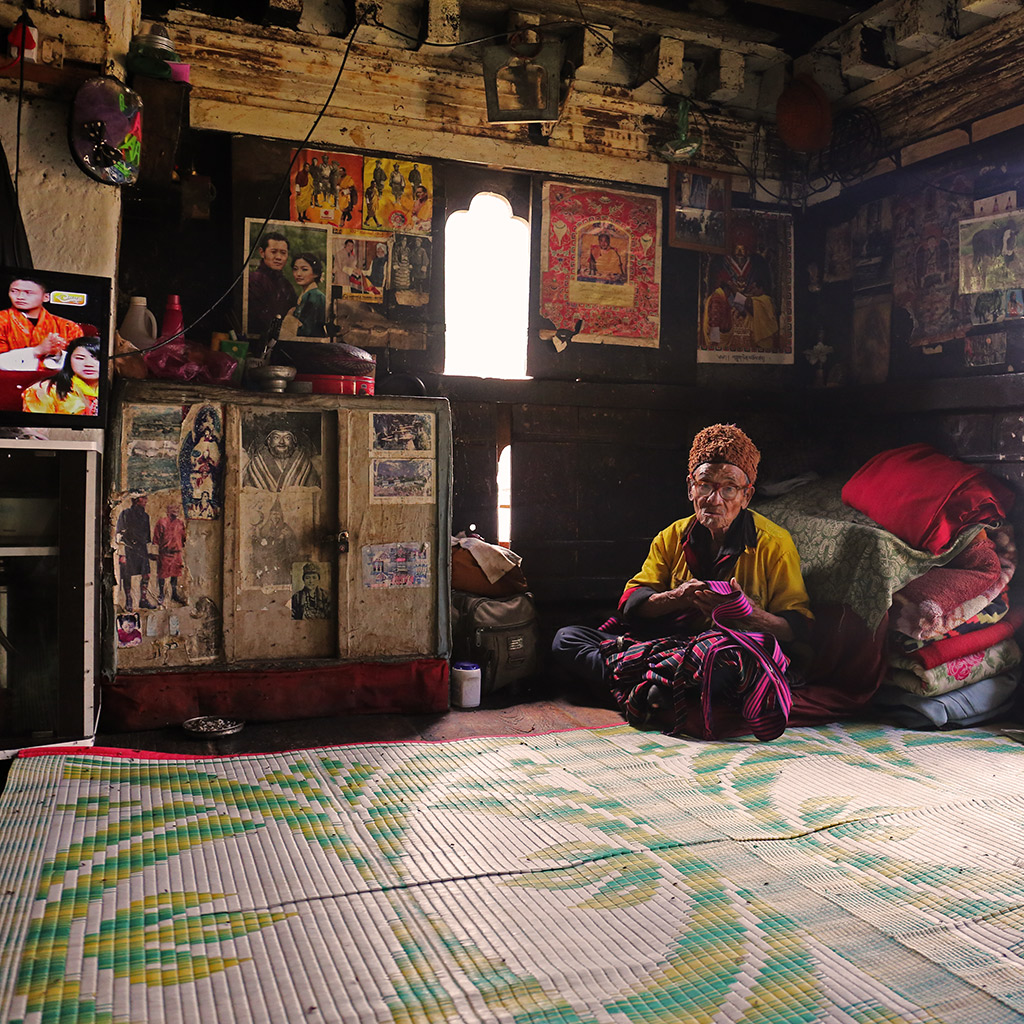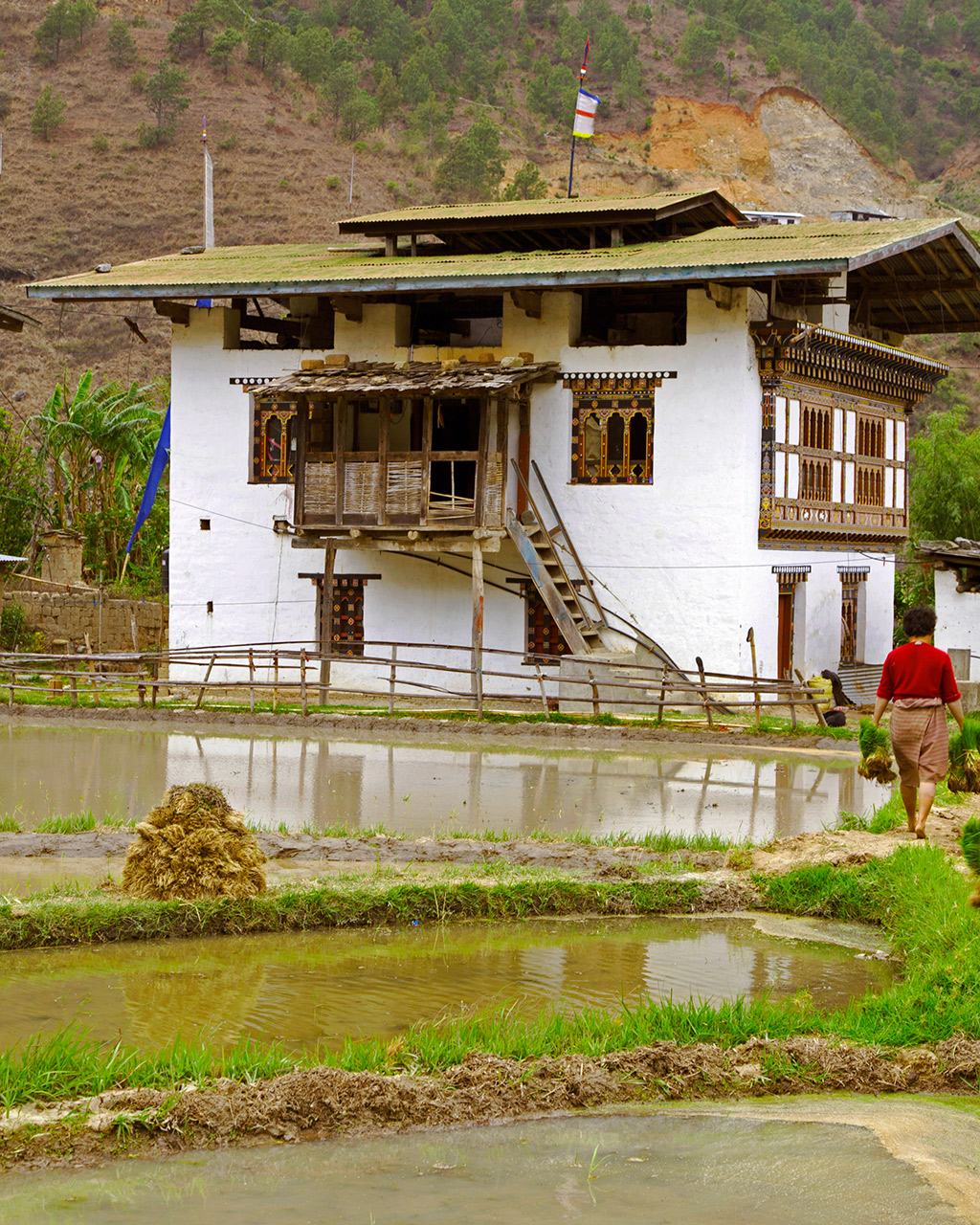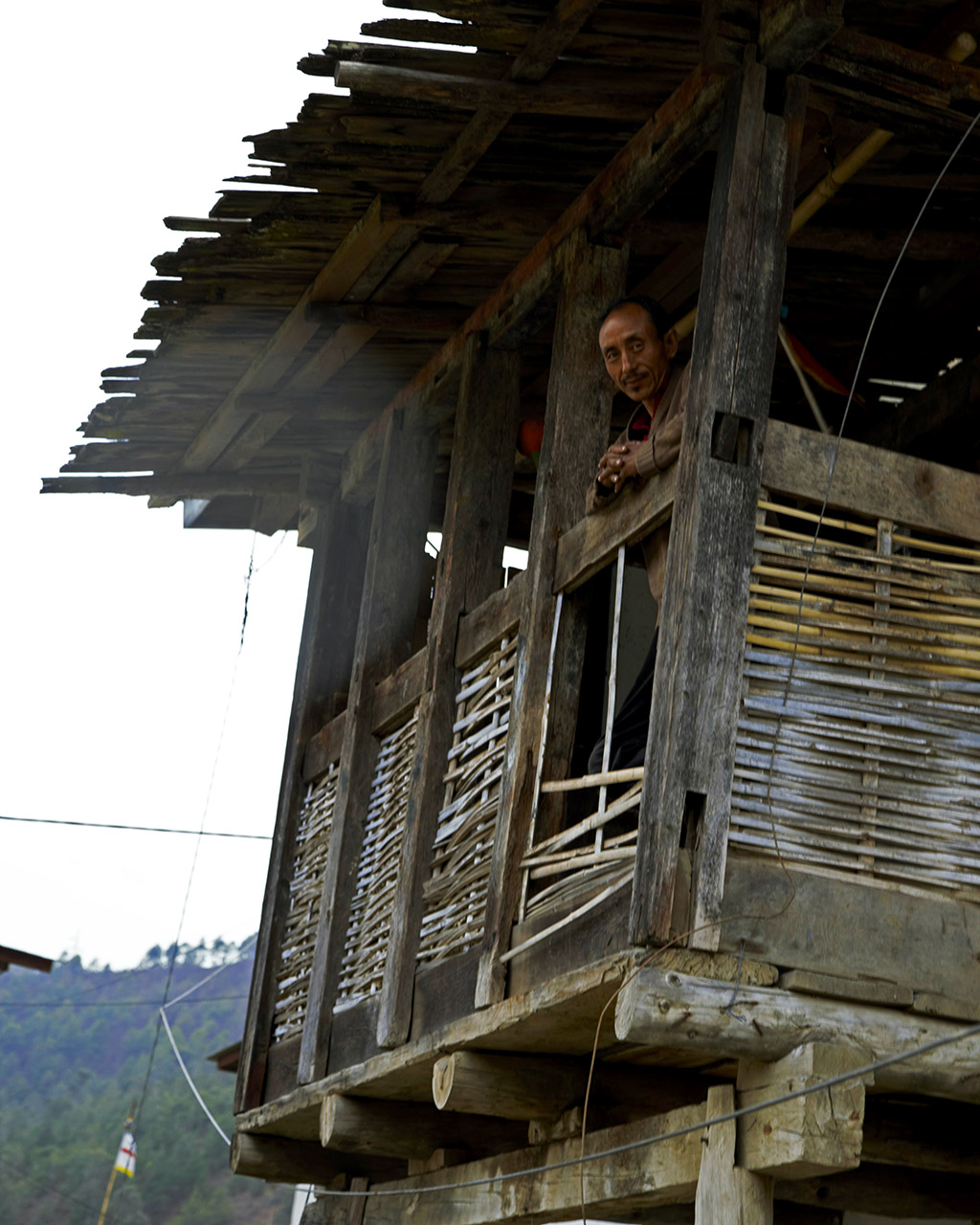The village that worships the Dzong

The road winds past the entrance of the Wangdue dzongDzongs are the fortress-monasteries of Bhutan and Tibet. The presence of Dzongs across the country symbolizes unification and the recognition of a central authority by the people in the region. Read More and moves down the valley, growing rugged and narrow as it goes. The paddy fields in the valley below are resplendent in their shades of green, a patchwork stitched together by the mud bunds that separate them. A cluster of homes comes into view, and Gyelmo weaves her way down through this path of her memory, stepping from one bund to another. She turns to greet an uncle as he walks past his front yard, and calls across the field to her cousin working there. Her banter prompts faces to appear at multiple windows, and an aunt comes out to one of the balconies, inviting us in.
The village of Nygeshegekhar has been around for many generations, the land once belonging to the Wang clan – ruling elites in pre-unified Bhutan. The original four homes are huddled together in a cluster at one corner of the field, and the other six homes, built over time, are spread around them. The Wangdue dzongDzongs are the fortress-monasteries of Bhutan and Tibet. The presence of Dzongs across the country symbolizes unification and the recognition of a central authority by the people in the region. Read More casts its protective presence over the village, and the ornamental facade of each house faces it, paying obeisance. This is typical of most villages, where the most decorated “face” of the home is presented towards the fields or to a dzongDzongs are the fortress-monasteries of Bhutan and Tibet. The presence of Dzongs across the country symbolizes unification and the recognition of a central authority by the people in the region. Read More if it is nearby, entrances being at the rear. The informal spaces between the houses and the fields become community spaces where children play or adults catch up over a domaLike elsewhere in South Asia, chewing doma pani (བདོག་མ་པ་ནི་) is popular throughout Bhutan. Also referred to simply as doma (བདོག་མ་), the collation consists of a quarter or more of the areca nut (Areca catechu; doma), betel leaves (pani or paan) as it is known in South Asia, and a dab of slaked lime (tsuni, derived from chunain Hindi). https://texts.shanti.virginia.edu/book_pubreader/40706….

The main house where Gyelmo was born and raised was one of the first houses in the village, and once home to Gyelmo’s grandmother and her siblings. As families grew and expanded, the village did as well. Most of the extended family lives in homes around the main house, with homes belonging to other residents slightly apart from the cluster. An elderly gentleman, one of the original inhabitants, tells us of a flood that forced the relocation of the original homes to a higher position. The positions of newer homes, for people helping in the fields or families needing more space, embody the fairly loose ownership structure of the village and its ability to grow organically.
Most of the younger generation no longer reside in the village full time, having moved to the cities for better opportunities. Each house in the village reflects the influence of returning sons and daughters, bringing with them modern ideas from the changing world outside. Gyelmo, her siblings, and her cousins, all of whom have moved to Thimphu, form a support system for each other in the city. They share their lives and bond over concerns about family back home. Visits to the village are defined by ritually calling on each member of the extended family, and carrying with them amenities and comforts.

One of Gyelmo’s cousins works in one of the upmarket hotels in Bhutan, and is visiting home for a break. She catches up with Gyelmo as they cook lunch for the community currently working in the fields. One can see influences of the city reflected in the arrangement of her mother’s house. Gyelmo’s aunt proudly struts around the house, showing us her new comforts. The house now boasts a more formal sitting room with wooden furniture, with a separate sleeping area partitioned off from it. The altar room has stayed untouched, but the kitchen has become a more informal space to gather. The shingles on the roof have been replaced by metal, making for easier replacement and maintenance. Additional structures to house cattle and a cattle kitchen have been added.
Gyelmo’s great-uncle lives with his wife in a home closer to the river. A natural organiser, he has been instrumental in helping build most of the new houses in the village. His two-storey residence is located a little distance from the main cluster, in the midst of his fields on a steep slope facing the dzongDzongs are the fortress-monasteries of Bhutan and Tibet. The presence of Dzongs across the country symbolizes unification and the recognition of a central authority by the people in the region. Read More. Age is catching up with him and working in the fields is growing difficult. He is exploring renting out the lower floor of his house, once a store for grain and meat. The large store has become fairly redundant, as he does not grow excess produce, and the need for an alternate income is critical. He sees the presence of a local migrant population, working to repair the Wangdue dzongDzongs are the fortress-monasteries of Bhutan and Tibet. The presence of Dzongs across the country symbolizes unification and the recognition of a central authority by the people in the region. Read More and on other infrastructure projects,as an opportunity. Many ground floors in the area are being converted to this use, changing the older patterns of use.

Not all the homes have changed, possibly due to a lack of resources, and this gives a visitor an interesting insight into how the architecture of the farmhouse may have evolved. Agay Gupdep Chago is another of the earliest inhabitants of the village. His home was one of those rebuilt after the flood, and is said to reflect an older style. Standing three stories high, it has a simple two room plan, probably to account for the steep slope. As with most homes, the ground floor is the store. The first level has a space for cooking and eating, demarcated visually from the sitting area by a wide three part doorway. A warm and intimate space, this is where Chago and his wife spend the entire day, looking out at the fields or watching their television. A deck used to lead to the rear from this level, but it is in a state of disrepair and has not been rebuilt. A ladder leads to the attic which accommodates an altar and a semi covered sleeping space. The backyard houses the toilet, and its multiple levels are used for drying and working.
Chago’s adult daughter lives here along with her husband and child, looking after her parents. Happy to share their lives and stories with visitors, the family appears to live in a time warp, connected to the present only through the television beaming them ideas of the world.
Vignettes





